Scaling Celeste Mountain I
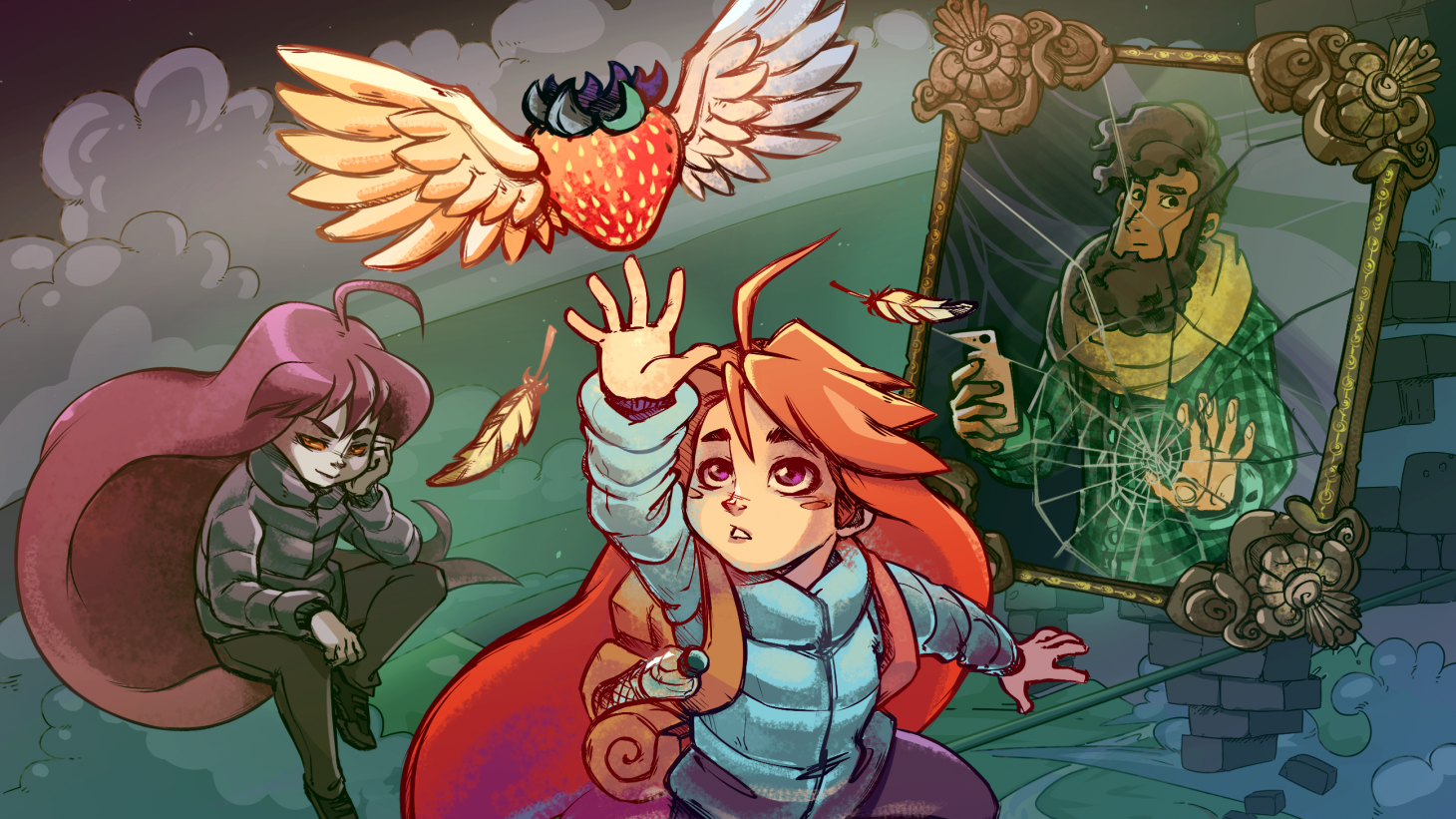
Celeste is one of the most memorable games I’ve played this year. A brilliant masterpiece, it developed in me a profound appreciation of games as a vehicle for creative expression. Read more about my journey in scaling Celeste Mountain in this three-part series.
Prologue: I’ve never been into video games when I was young.1 It didn’t occur to me that they can be subjects for serious thought or reflection. However, the lockdowns forced me to find ways to fill my weekends without programming; so I downloaded Steam, purchased my first few games — Terraria, Stardew Valley, Celeste — and made the jump.2
Introduction: the First Steps
Celeste is a charming platformer where you play a character named Madeline, a young woman dead-set on climbing the top of the titular Mountain. Along the way she’ll meet new friends, deal with her inner demons, and survive the hazards beset her trail.
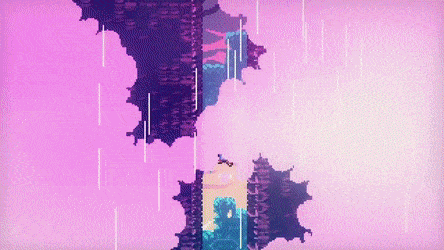
Sure, it’s just a game about climbing a mountain, but it triumphs by pulling me in to the struggles of Madeline, and connecting it to my own experiences without feeling forced at all. Celeste was able to achieve this with its (1) masterful storytelling, (2) tight mechanics and gameplay, and (3) genius use of music. By seeing how these three were weaved together into a singular experience, I developed a profound appreciation for video games as a medium and saw its potential for creative expression.
It triumphs by pulling me in to the struggles of Madeline, and connecting it to my own experiences without feeling forced at all.
I decided to break this post into a three-part series:
- Part I: Introduction and Storytelling (this page): I’ll introduce Celeste the game, and talk about how its strong narrative has drawn me into completing it.
- Part II: Mechanics is the Message, Story in Sounds (August 15): I’ll talk about how Celeste’s precision-platformer mechanics and masterful soundtrack contributed to the storyline and enriched the gameplay and experience even further.
- Part III: Conclusion (August 22): in the final part of this series, I’ll end with a short Conclusion and reflection on Celeste overall, how it changed my perception on video games, and more.
Spoiler Warning!
This review will contain a lot of spoilers in Celeste the game. If you haven’t played the game, try it out first then come back later!
Reach for the Summit
For the next three sections, I’ll discuss how the narrative, mechanics, and music reinforce one another to form a cohesive experience. This interplay made the game stand-out: nothing feels shoehorned-in, everything fits perfectly like a platforming puzzle.
Nothing feels shoehorned-in, everything fits perfectly like a platforming puzzle.
Masterful storytelling
Celeste’s story is simple yet packed with an emotional undertone: Madeline, our protagonist, wants to reach the peak of Celeste mountain. What makes it masterful is on how it was able to make me empathize with Madeline, both in-game and in real-life.
It has a light-hearted exterior: I personally enjoy meeting the quirky side-characters with their silly, gibberish, and garbled voices:
<iframe width="560" height="315" src="https://www.youtube.com/embed/gX0JCVgfAYU" frameborder="0" allow="accelerometer; autoplay; encrypted-media; gyroscope; picture-in-picture" allowfullscreen></iframe>
Clip: If those gibberish voices didn’t charm you, I don’t know what will
However, behind this cheerful backdrop lies a tale about anxiety, depression, and the difficulties of modern life. Madeline suffers from panic-attacks, drinks, and gets stressed. In one of the early sequences of the game, she encounters Badeline, her dark alternate, who serves as a physical manifestation of her fears and anxieties. From that moment forward, Badeline will taunt and chase me, culminating in an epic boss battle in Celeste’s penultimate chapter.
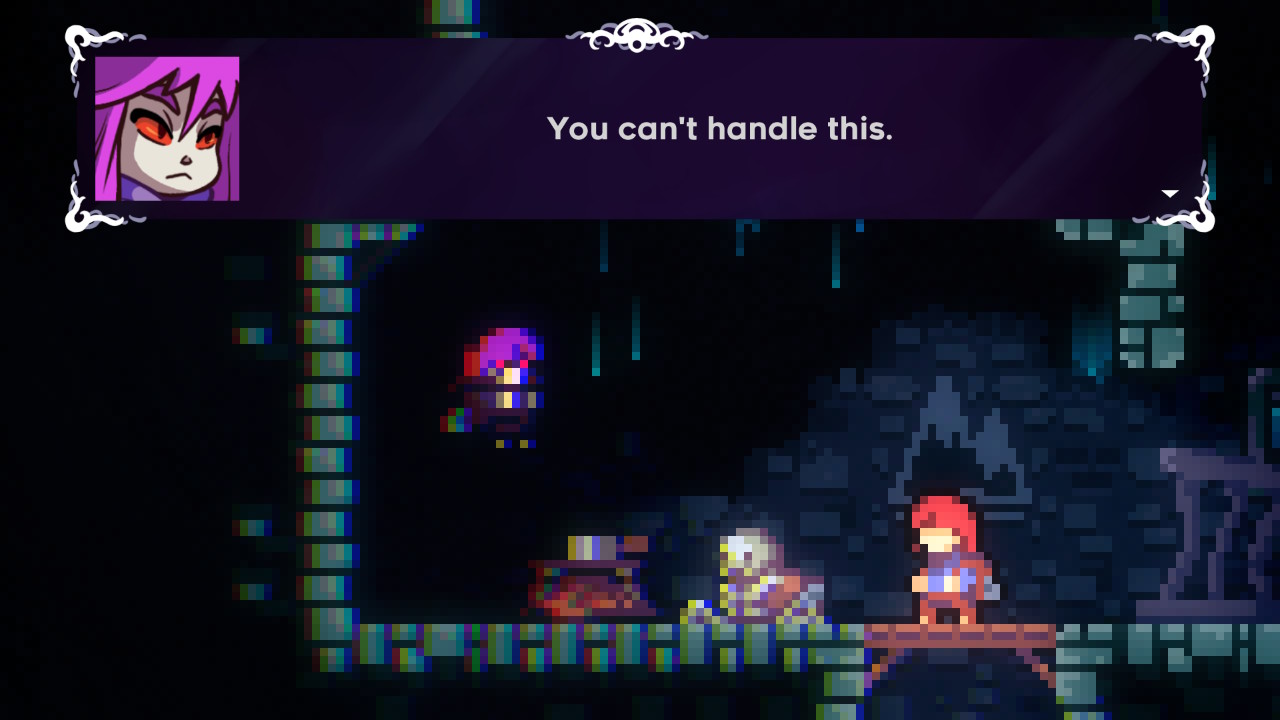
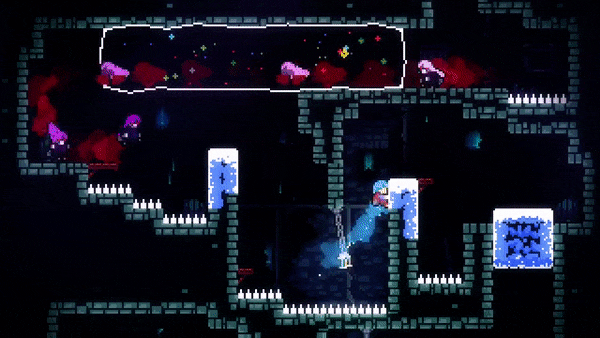
Run for your life: One of the earlier Badeline chase scenes in
Chapter 2
Her motivation for the climb, “to overcome and accomplish something,” wasn’t made explicit. I believe it was intentional so that we can project our own goals and struggles as we play the game— and this is where its genius lies:
Inasmuch as she [Madeline] wants to conquer Celeste the Mountain, metaphorically representing her life’s insurmountable challenges, I also want to conquer Celeste the game, and perhaps my life’s insurmountable challenges too.


Why Climb the Mountain?: Madeline’s motivation wasn’t made explicit so that we can project our own goals and struggles as we play the game.
I empathize with Madeline because inasmuch as she wants to conquer Celeste the Mountain, metaphorically representing her life’s insurmountable challenges, I also want to conquer Celeste the game, and perhaps my life’s insurmountable challenges too. This two-fold interplay between in-game and real-life experience helped propel the story forward. In some ways, I am Madeline; not only because I play her character (her deaths and successes are my own), but also because I experience her struggles and motivations. Her story does not end even after I close the game or beat it. It continues to exist and grips me in this reality.
Her story does not end even after I close the game or beat it. It continues to exist and grips me in this reality.
Another thing that I like about Celeste’s storytelling is on how it treated its subject-matter delicately. It approached the topics of anxiety and depression with kindness— not with an overly-pedantic tone. Acknowledging the innate difficulty of precision-platformers, its message in the prologue is full of hope: “You can do this.”

A message of hope: One of the earlier messages you’ll see as you play the
game.
It never said “Hey, just talk to your friends!” or “Just do some meditation!” Instead, it presents you a heartwarming conversation with Theo, and a mini-game about a golden feather.3 The latter was particularly special because it caught me off-guard: it serves a perfect blend of gameplay, storytelling, and emotion on the experience of panic-attacks.
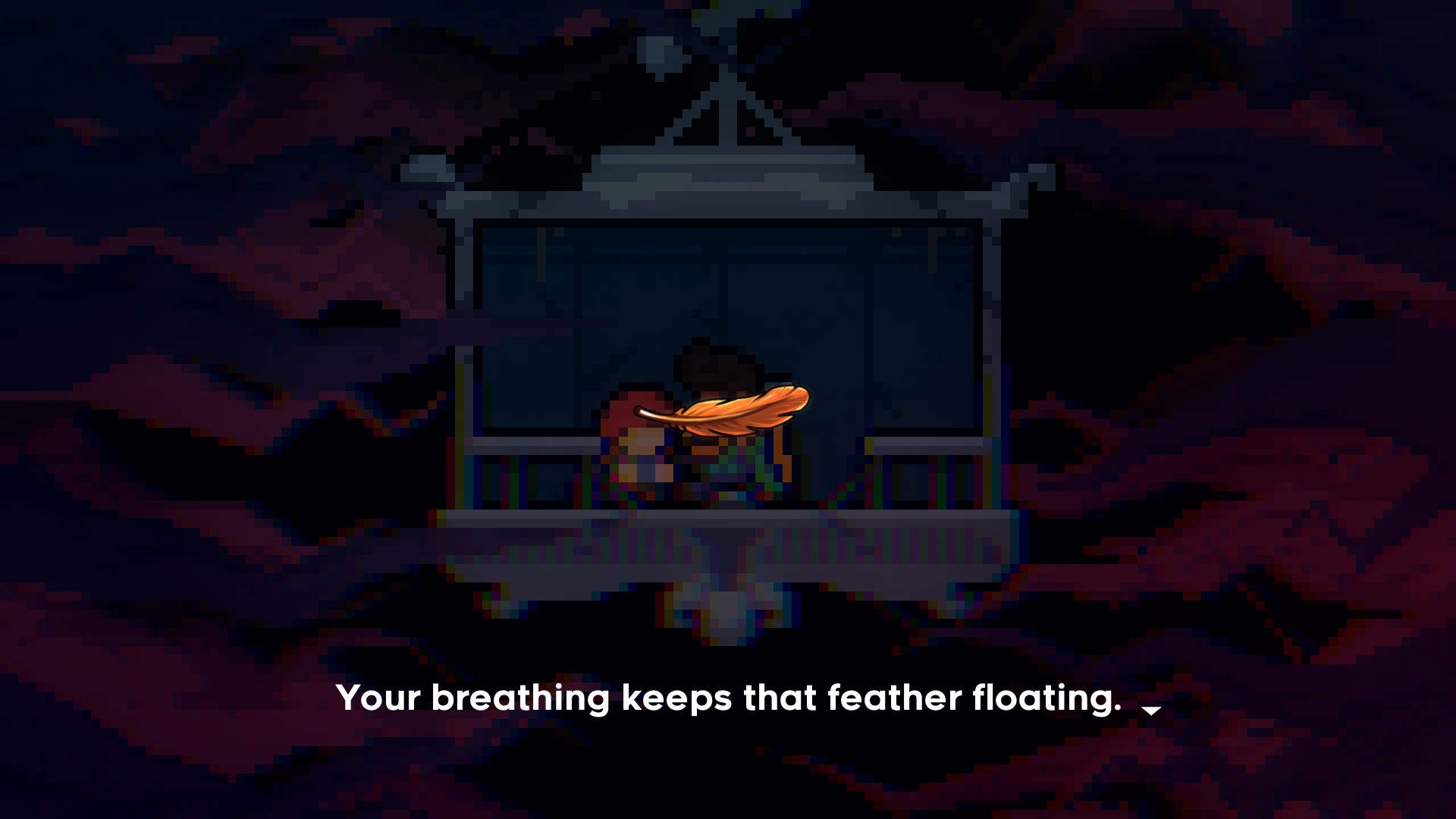
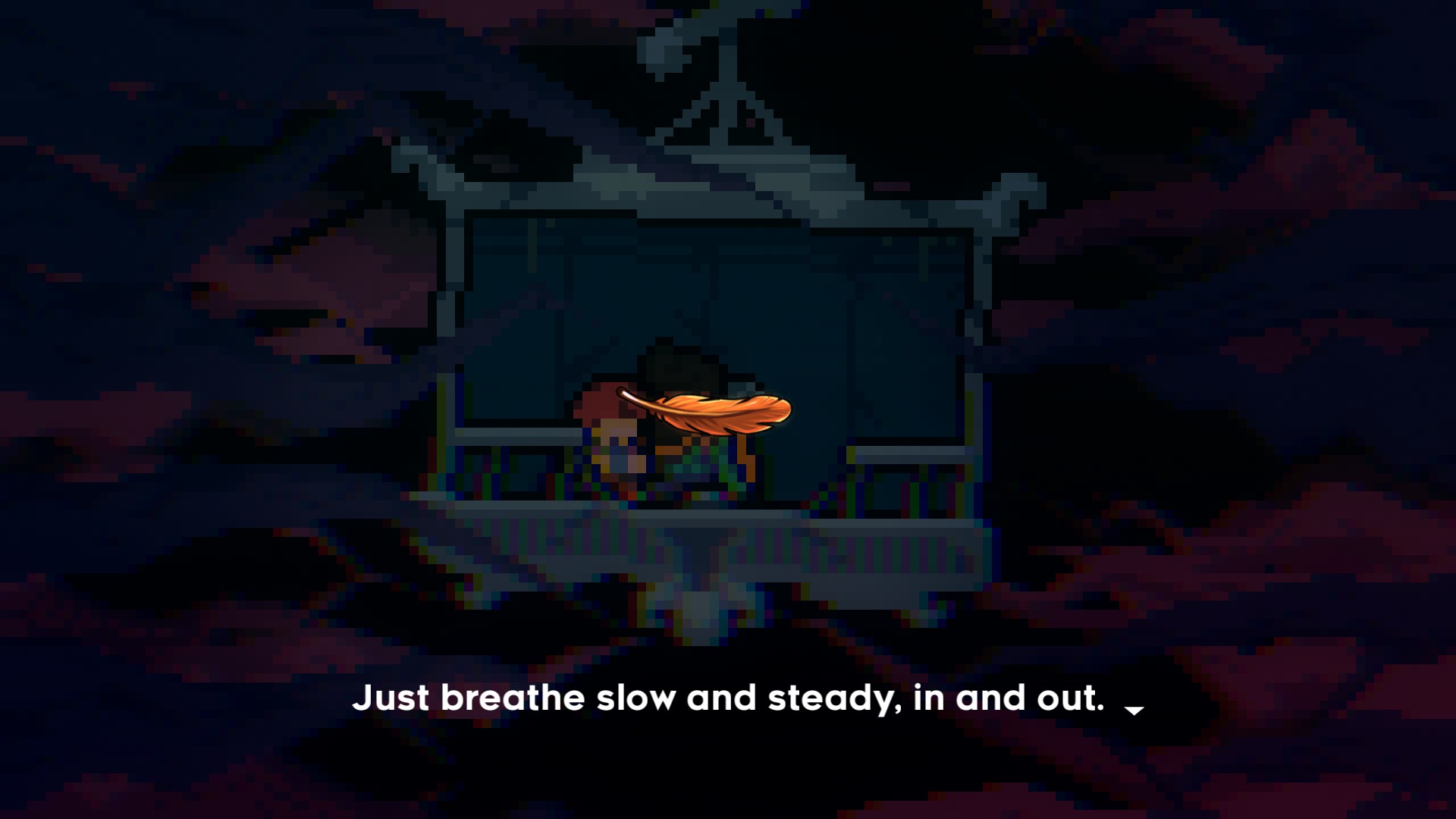
Stay afloat: A highly-emotional scene introduces the golden feather
mini-game— a breathing exercise that I still do today.
Because of that, the “conclusion” of Madeline’s struggle is very well-earned. At the start of Chapter 6, just a few more distance to the summit, she will fall back to the start and is again confronted by her dark side:

Quiet and Falling: At the penultimate chapter, Madeline will fall back to
the base of the Mountain.
By the end of its penultimate chapter (and again, after an epic boss chase sequence), Madeline realizes that instead of running away from Badeline, who represents her fears and anxieties, she must learn how to work and function with her. Overcoming depression is not about defeating it, it’s a Part of Me that I need to accept and embrace.
It’s also noteworthy that “Badeline” isn’t the in-game (or official) name of Madeline’s doppelganger. It’s merely born from the gaming community’s need for shorter names. In-game, she’s only referred to as a Part of Me/You. In my opinion, this helps because we avoid labelling this Part of Us as “bad.” I think that without this pre-judgment, we can be more comfortable embracing it, the same way Madeline did.
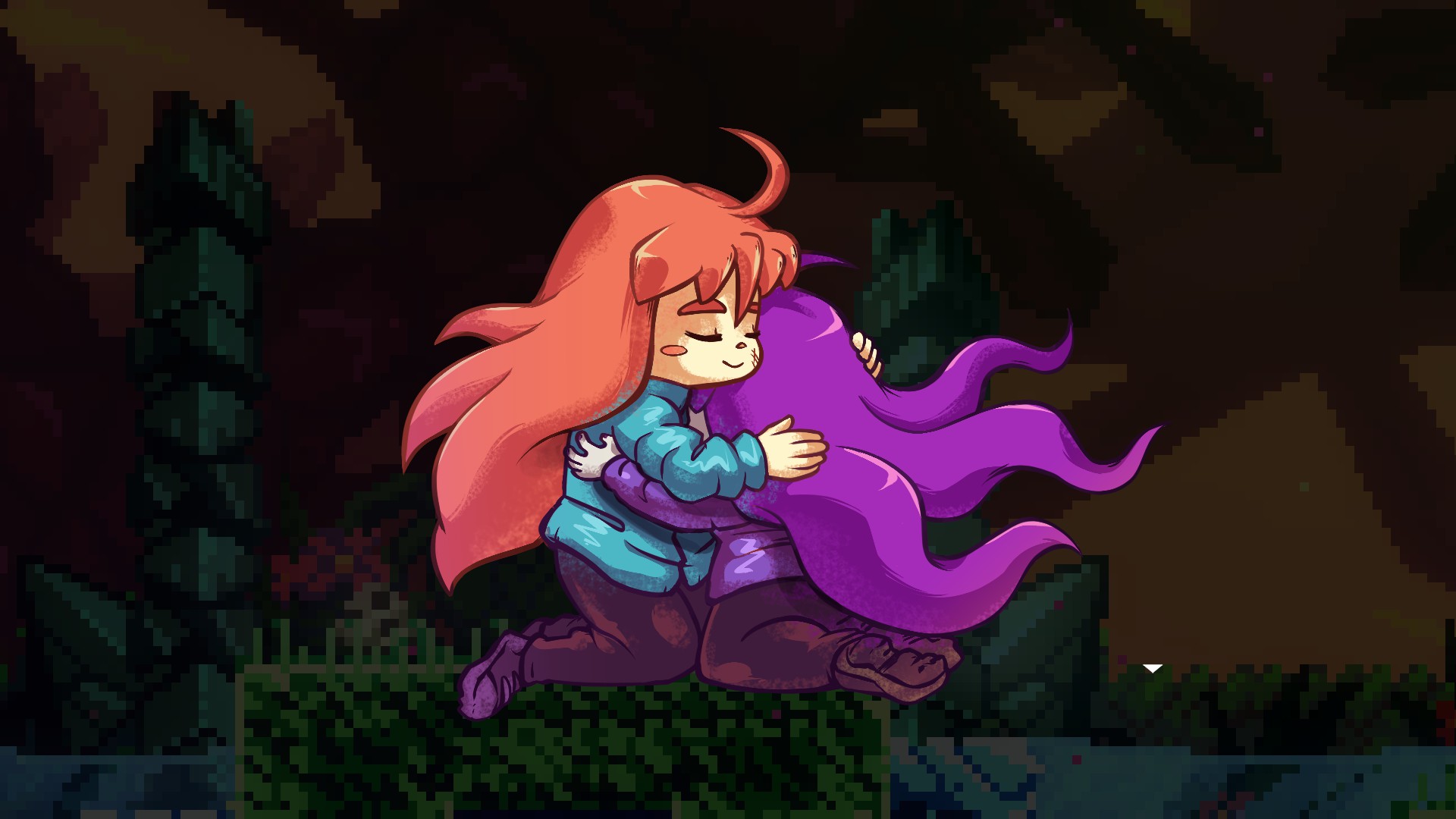
Acceptance: Madeline and Badeline share a hug
Upon this realization, Madeline and this Part of Her will fuse, granting us the ability to double-dash, for the final chapter to reach the summit.
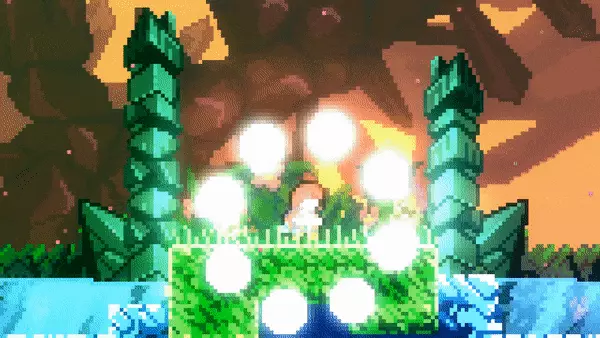
The climb towards the summit isn’t easy, even with the double-dash power-up (it’s a culmination of all previous chapters’ environmental mechanics made difficult). However, the journey towards the summit shows that dealing with one’s depression is a process: we see Madeline and this Part of Her converse with one another, and work towards their differences as they traverse through the Mountain.
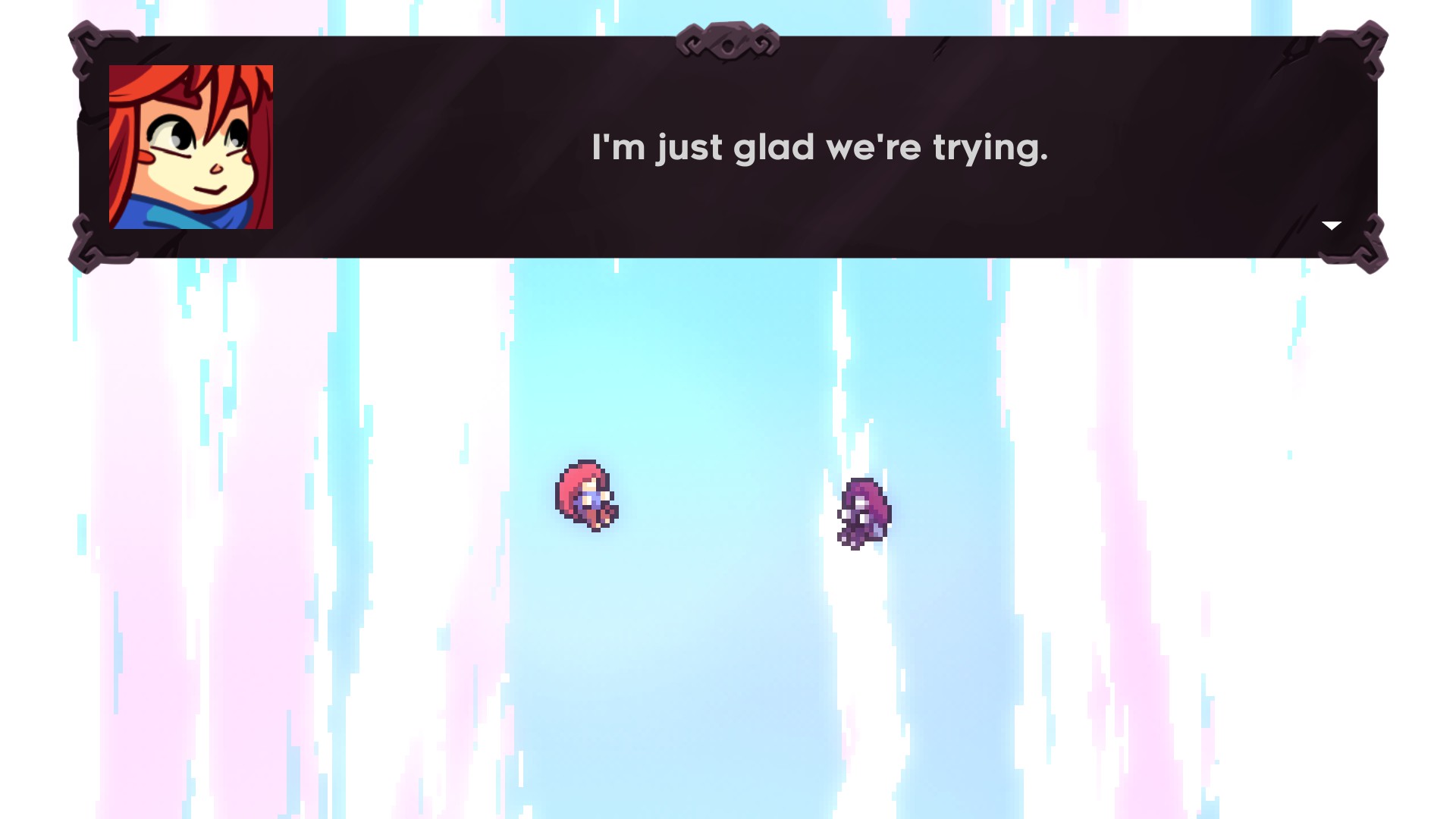
Celeste’s storytelling is masterful because it enables us to empathize with the main character’s struggles, and it continues to live outside the game. Madeline and I share the same struggles—both in a platforming and real-life sense—and by extension, her successes and failures are also my own. Upon reaching the Summit, we’re shown a picture of Madeline staring over the horizon. I leaned back to my chair, took in the view, and felt a sense of elation and joy upon realizing what we’ve accomplished.

In the next section, we’ll see how this tight storyline was made more vibrant by weaving it through its intricate gameplay and solid mechanics. Remember, Celeste is not a Telltale Adventure game where you just click conversational cues, it’s a hard-platformer that demands creative problem-solving and precise inputs to overcome immense difficulties.
Next Sections
- Part II: Mechanics is the Message, Story in Sounds (August 15): I’ll talk about how Celeste’s precision-platformer mechanics and masterful soundtrack contributed to the storyline and enriched the gameplay and experience even further.
- Part III: Conclusion (August 22): in the final part of this series, I’ll end with a short Conclusion and reflection on Celeste overall, how it changed my perception on video games, and more.
-
The last console I had was a PSOne (the big boxy version) from my uncle, and a Gameboy SP back in grade school. I did play some games casually (Final Fantasy Tactics Advance, and Pokemon Sapphire comes to mind), but not with a deeper appreciation that I have today. ↩
-
I still do some open-source work such as answering Issues and reviewing PRs, but sometimes you just want to take a break! The last open-source project I did was Sprites-as-a-Service, go check it out! ↩
-
I later learned that the golden feather minigame was based from an actual floating feather meditation technique. Someone replicated the mini-game that you can try out (although I believe the experience will be more complete if you played the game)! ↩